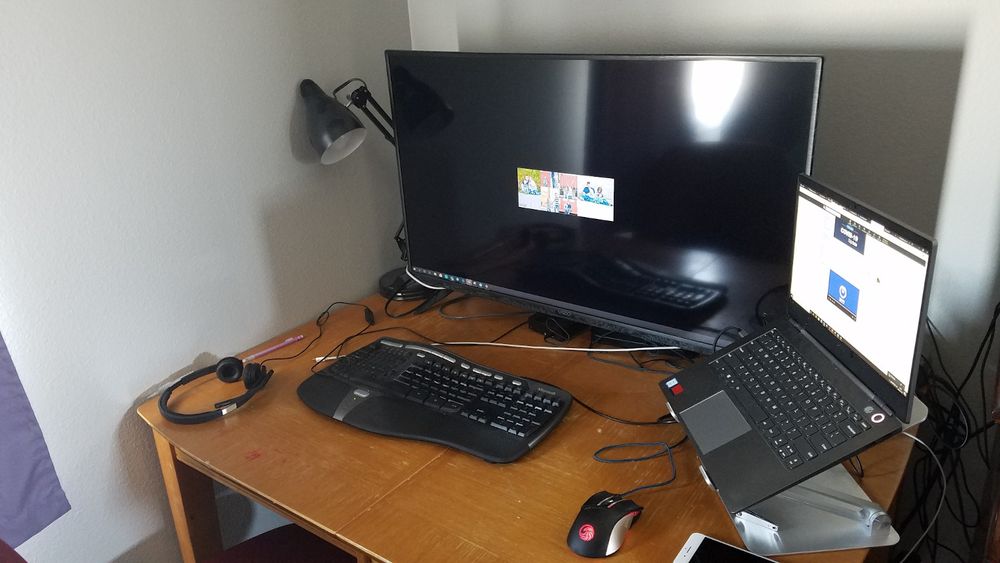My Unconventional Monitor Setup
Last summer, my work place put into place a remote work policy. I jumped at the opportunity to work from home a few days a week, and overall it's been something I think is very positive for me personally and the company.
One of the challenges to this was figuring out my setup regarding my monitors. I previously had two smaller monitors I had used as a work station at home. They were typical 1080p monitors, but not very large. They worked ok, but I always wished I could fit more on them vertically. They were small, and investing in more 1080p monitors was just not something I wanted to do, nor would my systems have the capability to drive the amount of screen real estate I was looking for. Not to mention, the mounting options I would have to deal with to stack them with an ugly bezel in between.
I looked through a few options, but to get decent size monitors now-a-days that also look good gets expensive quick. I decided to take a more non-conventional approach to my next monitor. That was to use a TV!
One of the great innovations in TVs over the past several years is the introduction of 4K TVs. In brief, these TVs have 4 times the amount of pixels on the screen of a 1080p screen. A pixel is a tiny dot on the screen. The more pixels on a screen, the more detailed a picture can be become, especially around shapes with curves or tiny details. The fewer pixels, the more jagged images and text on the screen becomes. This becomes more apparent closer to the screen, or the fewer pixels a screen has.
This all comes down to pixel density- how many pixels fit on a screen. A key measure of this is DPI (dots per inch)- assuming an even distribution of pixels, given a vertical or horizontal line of pixels an inch long on the screen, how many of these pixels (or dots) fit into it?
This made me think, could I use a small TV as a desktop monitor? I'm not talking the big 65" TVs, but what if I take the smallest 4K TV I can find and use it as a monitor. Well in this case it was a 43" 4K Vizio at Best Buy.

My existing monitors were 21.5", with a typical 16:9 aspect ratio, this means they are about 18.73inx10.54 inches with a pixel density around 102 DPI. Since going up to 4k would quadruple the number of pixels on my screen, I could double the diagonal of my screen and have the same pixel density. A 43" 4K TV would have the same pixel density as my 21.5" 1080p screen. Yippie!
I took the plunge and bought the TV. They are very affordable when I compared the price vs computer monitors. I figured if it didn't work out, I could replace one of the aging TVs in my house with it.
Overall, I think this was a great change for me. Going from two monitors, to one TV, I'm getting roughly 2x the screen space at a lower price point. I can stretch out my IDE when I'm coding to take up a lot more vertical space--more code on the screen, makes me a happier developer. I can keep multiple applications open and space them out across the screen and not have to perform lots of window or virtual desktop switching. Since it's only one display, it only takes a single wire to go to my computer. It's also got built in speakers, and I have a multitude of other options for inputs I never had on a monitor.
There were several things I had to tweak in my TV monitor:
- I reduced the blacklight on the TV. These TVs can blast out light, and are typically made to be viewed from further away, rather than sitting close to them. It can fatigue eyes pretty quickly with the default settings.
- Scaling the display resolution to increase the text size slightly. Even though the DPI and text was roughly the same size as my old monitors, I liked being able to increase the window chrome and text size in my OS to a comfortable level. Since I have so much extra space on my TV, I feel like I can do that without sacrificing screen real estate. I could have never done that with my old PC monitors.
- I reduced input lag by turning on "Game Low Latency". Many TVs have extra processing in place to improve viewing for TV and media. That's very understandable as typically a TVs primary function is to watch media. This introduces some latency that typically isn't an issue in those formats, but can be noticeable at times when interacting with the TV from a computer. Be careful, not all TVs will have this option, or the terminology will be different. The setting really isn't that noticable though.
I just want to close by saying this worked out great for me, but is not for everyone. If you decide to try it, don't just take my word for it. Really think about what works for you in your environment, and ergonomics. Make sure to research the TV you're buying will fit your requirements as TVs vary greatly in quality and capabilities from brand to brand.